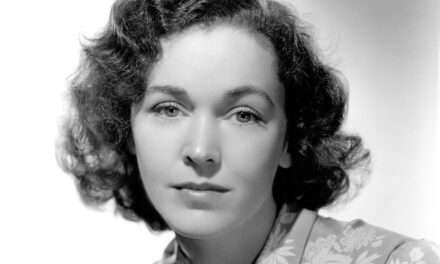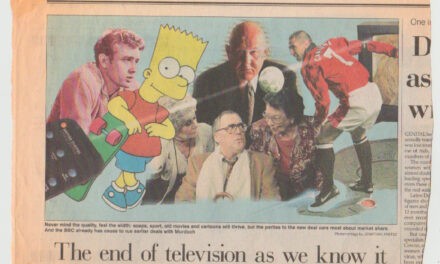Making and Remaking Television Classics, 20 March 2009, University of Warwick
Rachel Moseley writes:
Most people have a sense of what might count, for them, as ‘classic television’. From long-running serial drama like Coronation Street, to Sunday evening dramas such as Upstairs Downstairs and Pride and Prejudice , or the nostalgic pull of 1960s children’s programming like Pogles’ Wood, the term has great resonance in relation to one’s personal television history. The notion of ‘classic’ television is also, even where it is (most commonly) implicit, high on the agenda of teaching, publishing and research within television studies. In this sense, there is some slippage between the idea of ‘classic’ television and a television canon: we select texts for teaching because they have been considered historically or aesthetically significant, or because we think they should be considered so. Academic publishers might publish research on television programming that has received critical and popular success (for example I.B. Tauris’ Reading…. series of books on contemporary American television drama). We might, then, in some cases, orient our research towards projects which we have a sense might get published. The BFI publishes its TV 100 list. Arnold publishes Fifty Key Television Programmes (Creeber 2004), and we argue about which ‘classics’ have been omitted. Popular canons are created and reinforced through television ‘top TV moments’ programmes.
However, while the idea of classic television is a commonsense and widely used one, the meaning of the term has barely, with a few notable exceptions been interrogated (for example Brunsdon 1990, Kerr 1982, which think about ‘classic’ television in relation to questions of quality and literary adaptation). Several years ago, when the BFI began its series of short ‘Film Classic’ books, the Midlands Television Research Group began to think about drawing up a list of ‘Television Classics’. More recently, BFI Publishing began its series of short ‘TV Classics’ books, based on a list drawn up through discussion with academics and BFI staff, one of the criteria being that the programme in question must be available to view on DVD. This developing list, then, is one of the key sites in which definitions of classic television are being made and remade. Stella Bruzzi (Warwick) and Karen Lury (Screen), then, decided to focus a University of Warwick Screen anniversary event around an interrogation of the notion of ‘classic’ television.
Accordingly, one in a series of events marking the fiftieth anniversary of the journal Screen, ‘Making and Remaking Television Classics’ was a one-day symposium jointly hosted by Film and Television Studies at the University of Warwick/The Midlands Television Research Group and Screen. BFI Palgrave, publishers of the TV Classics series, sponsored the event’s evening reception. Our aim in developing the day was to provide a stimulating forum, in which the invited speakers could address and perhaps challenge the notion of the television classic, leaving plenty of time for discussion and debate. The structure of the day was designed to enable this: after Christine Geraghty’s keynote paper, there were two sessions where traditional twenty minute papers were presented, but also an afternoon session of a series of short, clip-based presentations. This format enabled us to accommodate a wider range of viewpoints than would perhaps be possible in a more classically organised symposium. The day was exceptionally well-attended, with established scholars who had previously engaged in the ‘classic television’ debate and TV Classic authors sitting alongside emerging scholars and PhD students. Debate was lively, engaged and sustained, and, in what follows, we hope to give a flavour of the day’s discussions.
Christine Geraghty’s opening paper generated a number of key questions to which papers and discussion throughout the day returned. Making a fruitful comparison between what constitutes ‘classic’ in fashion (the sleek, simple and dateless), she asked whether such a definition could possibly work for television? Indeed, she suggested, often it is precisely the ‘snags and frills’ that are the markers of a television classic. Closeness and present-ness might be more, or just as, important in defining classic television, than longevity. Indeed, ‘classic’ television is perhaps less clearly seen when taken out of time, becoming a reflection of past times and pleasures. Herein, perhaps, lies the problem of classic television. Robin Nelson’s formal contribution also considered the tension between ‘classic’ status and personal response, for example in what is required of authors contributing to the TV Classics series, through the notion of ‘standpoint epistemologies’. Is it possible, he asked, to articulate a principled position’ between relativism and universal values? John Caughie’s recent volume in the series on Edge of Darkness was suggested as a possible model, in which taste formation is acknowledged as personal and affective, but intellectual engagement is the grounded ‘somewhere’ that the view presented is from. Discussion pondered on whether the ‘classic’ can in fact have meaning outside of personal taste, and if so, how that might be defined. Is a television ‘classic’ a first, ‘typical’ or ‘best’ example of its kind?
Kim Akass and Janet McCabe, as editors of several volumes in I.B.Tauris’ Reading…. Series (Akass and McCabe 2004, 2005; McCabe and Akass 2006, 2007), were well-placed to comment upon the recent trend in research and publishing on that quality American television drama which is rapidly (and perhaps sometimes prematurely) accorded ‘classic’ status. Thinking about HBO as a site around which modern ‘classics’ are currently being produced, they considered the notion of the classic as a discursive construct, and one that is being self-consciously used in the channel’s production and promotional strategies. The channel’s most successful dramas are based upon existing ‘classic’ American genres (gangster, western), and so the notion of the classic is recycled and reiterated in the careful (cynical?) production of new instances. The importance of understanding the role of industry in commissioning and producing classic television in the contemporary moment, then, must be acknowledged.
The series of ten minute, mainly clip-based papers broached argued for ‘forgotten’ classics (Sarita Malik on King of the Ghetto, who also thought about the question of ‘standpoint epistemologies’, the importance of personal history in its relation to television and the ‘classic’, and raised questions around the archiving of certain kinds of television), and factual television as ‘classic’ (John Corner on Living on the Edge, who also engaged with the idea of ‘people seen more clearly’ and the documentary imagination). Glyn Davis considered reality television as a model for classic television, using America’s Next Top Model and the idea of ‘ugly pretty’ superceding ‘pretty pretty’ to give a broader sense of value and worth, and further suggested the possibility of classic television ‘moments’ as opposed to programmes. Rebecca Barden, editor of the TV Classics series, addressed the role of publishing in producing television classics and very usefully discussed some of the processes and criteria that the series and its editorial board had considered in commissioning works for the series: innovation? historical importance? critical acclaim? availability on dvd? the desire to watch again? balance between celebration, innovation and rediscovery, the familiar and the unknown?). John Caughie urged the room to ‘own up to’ the canon and the classical, and to address sedimented notions of taste. His paper asked a series of questions about how the classic can be understood, and, for example, how the old classic might be differentiated from the ‘modern’ classic, and was suggestive about whether these terms might be mapped onto notions of the classical and the modernist.
In the final session, Jason Jacobs, Helen Piper and Lez Cooke ranged from contemporary, to nostalgic and popular, to unknown classics. Taking HBO’s Deadwood as his example, Jason Jacobs wondered whether classic television has first to be recognised as television, before it can become anything else, and showed how Deadwood’s dramatisation of themes of transcience and settlement might be mapped on to notions of the ‘classic’, offering aesthetics as epistemologies. Helen Piper asked us to think about the more colloquial sense of the term ‘classic’, and the way in which it can epitomise the routineness of television, using the example of ‘a “classic” example of Dad’s Army ‘. Her paper considered the collective enjoyment of remembering through televsion’s tribute programming, and the way in which use of the archive in this way produces a continuity with television’s past. Her closing question asked whether we are mistakenly reifying experience as text, by celebrating certain texts as classic, returning us to Christine Geraghty’s opening comments about the way in which classic television might be that television which is intimately tied to personal history, memory and space. Lez Cooke’s argument for two ‘unknown’ classics, Anastasia (1959) and Three Ring Circus (1961), raised the question of whether barely seen programmes can be classics, and the multiple definitions of the term that the day had set out to open up. As Glyn Davis commented, perhaps television becomes classic precisely when you cannot access it.
As with any event of this kind, conclusions were not drawn and, indeed, such closure was not our aim. Our hope for the day was to engender discussion of a notion that has seemed simultaneously frustrating, convenient, useful and nebulous; its nebulousness, perhaps usefully, remains, but the debate has been opened.
Karen Lury writes:
As an editor of Screen, with a particular interest in developing Screen’s participation in the lively research culture that characterises television studies in the UK, I was very grateful that Stella Bruzzi and particularly Rachel Moseley were so enthusiastic and supportive of my suggestion that Screen stage a symposium as one of several ‘50th Anniversary’ events celebrating Screen’s longevity. As Rachel indicates in her comments, the choice of Warwick seemed entirely fitting. Stella and Rachel’s hard work and energy in attracting additional support from the University of Warwick and from Palgrave/BFI ensured the day was a real success. In our initial conversations and in the ultimate structure for the day, we tried to provide a framework for debate, which responded to a couple of key concerns.
- How could we organise a television event that would cut across genre and time periods? Could we bring people in to speak in a way that would avoid an exclusive focus on television ‘history’ or on ‘drama’ or ‘reality TV’?
- How might we reflect on the relationship between research, publishing and teaching?
By attracting a variety of excellent speakers and a large number of participants, we succeeded in opening up debates around the heritage and future of television studies in the UK.
As Rachel has already suggested in her comments, Christine Geraghty usefully framed her introduction to the day in relation to the term ‘classic’. Implicitly, her focus on the elasticity of the term also suggested to me that there might be two ways of articulating, or emphasising the word classic itself. First, we might articulate the term as ‘class- ic’ placing the emphasis on the notion of ‘class’ or pedigree, and thus relate the term to programmes that are the ‘best’ of their kind and which – probably – are also ‘class-y’, demonstrating a particular kind of sophistication. As such, this would refer to programmes that, as John Caughie might say, are distinguished by the way in which they are ‘unapologetically complex’. (Shooting the Past, The Tenant of Wildfell Hall, Edge of Darkness.) An alternate emphasis however, might be ‘class-ic’ where the term is articulated colloquially (‘from the street’) and where a ‘class-ic’ programme provides, accidentally or deliberately, that ‘perfect moment’ a moment that is charged with affect – emotional and/or political. This would relate to regular but extra-‘ordinary’ programmes that are emotionally, historically or socially significant – which are as, Glyn Davis suggested, ‘ugly pretty’ rather than ‘pretty pretty’ (America’s Next Top Model, King of the Ghetto, Living on the Edge.) Of course, some programmes might meet both these criteria (Civilisation perhaps) but others clearly don’t. The contrasting implications of ‘classic’ as a term which might make sense very differently when heard in the gallery or from the street was neatly, if rather accidentally, crystallized by Alistair Philips’ bewildered response to the ‘speed’ and apparent banality of the clip chosen from America’s Next Top Model (shown by Glyn – not co-incidentally – via youtube).
In addition, Christine’s focus on specific moments of television performance (the seemingly accidental but poignantly affective re-arrangement of a bra-strap in an early scene from Coronation Street) aligned with her suggestion that we might also acknowledge television’s universal attributes (to see people ‘more clearly’) also fore-grounded another important aspect of the day’s debate. This was the way in which speakers and participants were obliged to think again about the complexity of our ‘object of study’. This is, as everyone knows, the fact that ‘television’ is both a series of quite radically different texts but that it is also a form (or should that now be a platform?) which brings or binds these texts together and which is further implicated or informed by its relation to certain production practices, audiences and social imperatives. In this sense, many speakers were keen to address the relation between television programmes and television as a medium. This, it was suggested, may be increasingly important when it is evident that television’s production practices and its modes of distribution are shifting – even if, they are, in fact, shifting ‘again’ as Charlotte Brunsdon reminded us, since television has, as she noted, forever been ‘in crisis’. In terms of the ‘TV Classic’ this distinction might be framed as whether a programme should be categorised as a classic because it was important or interesting in itself or whether because it was important to television. As Janet McCabe and Kim Akass suggested, this is further complicated by the actions of producers and broadcasters (yes, HBO but also increasingly for some programmes, the BBC) who now actively seek to ‘brand’ their programmes in a way that pre-determines the programme’s apparent ambitions and quality criteria. How can the critic respond to programmes which work hard to convince their sophisticated audiences that they are recognisably ‘special’ before they are even watched, or at the very least before we reach the end of the title sequence? (John Adams, Six Feet Under)
As the day progressed I gained a sense in which the TV Classics series is caught up in a conflict of interest. This conflict might be characterised between the study of television as determined by the concerns of the ‘archive’ in contrast to the study of television as it might relate to the attractions of a ‘collection’. The motivation of a television archive is to preserve, to find and re-find, to establish a ‘taxonomy’ of television practices and programmes. It values those programmes that are unique, that are ‘evidential’ and may prioritise a particular object because of what it ’is’ rather than what can be said about it. Lez Cooke’s discussion of the ‘unknown classic’ is implicated here and Helen Piper’s desire to address the on-screen archiving of television by television was equally pertinent. In contrast to the archive, the ‘collection’ values what is ‘precious’, objects that are interesting in themselves or because they are beautiful. In this sense, the collection curates objects through a process that is determined by informed judgement, learned expertise or ‘taste’. The ‘authority’ that is awarded to a text located in the archive, is here substituted by the ‘authority’ of a reader, the expert who demonstrates to us quite why this particular object is so interesting. John Caughie, Robin Nelson and Jason Jacobs are aligned here in demonstrating eloquently what ‘reading’ a text can do.
Could we therefore agree on a ‘classic’? No. Did we enjoy, or find it useful, to disagree? I think so. Did the day reveal the real quality of work being done, and the openness and ambition in British television studies manifested by scholars of all generations, studying different genres and different periods of production? Yes.
Speakers: Kim Akass, Rebecca Barden, John Caughie, Lez Cooke, John Corner, Glyn Davis, Jason Jacobs, Christine Geraghty, Sarita Malik, Janet McCabe, Robin Nelson, Helen Piper.





